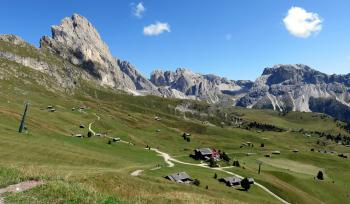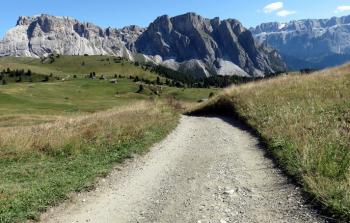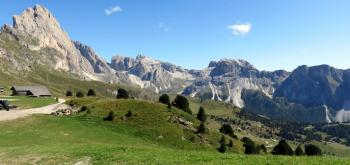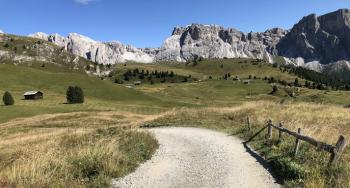Easy hiking in the Dolomites
This item appears on page 13 of the June 2020 issue.
The chalk-white ridges of the Dolomites in northern Italy provide accessible high-altitude hiking for people of all ages and abilities. This unique part of the Alps is composed of uplifted ancient coral reefs.
Alpine meadows adjoining the massive peaks put the hiker at eye level with cloud-capped mountaintops, so I was excited to be able to hike these high peaks by myself at age 75. I borrowed hiking poles and set off in mid-September 2019. I chose September to avoid the high tourist season, plus the weather was perfect for hiking in short sleeves.
Traveling there was easy. I flew nonstop from Austin, Texas, to Frankfurt, Germany, and connected with a short flight to Innsbruck, Austria. I paid Sudtirol Bus (www.altoadigebus.com) $100 for the 2-hour drive from the Innsbruck airport to Val Gardena (5,100 feet) and the town of Santa Cristina.
This valley has more than 76 lifts up to the meadow trails plus abundant restaurants and historic sites. I stayed eight days at Garni Le Chalet (Via Iman 32), a red-geranium-covered, 4-story, typical bed-and-breakfast hotel, for $68 per night.
Although my hosts, Franz and Maria, were in their 80s, they easily carried hot tea to my room up flights of stairs. Their warm hospitality and practical advice made my visit very enjoyable.
German, Italian and Ladin are all used in signs and for conversations in the valley. For example, Ortisei/St. Ulrich/Urtijëi is a town name in Italian/German/Ladin. English is not as common except in tourist information (TI) offices. However, hand gestures and knowing a few words worked just fine for me, and many restaurants showed pictures of their food offerings.
I quite enjoyed the regional food, featuring hearty dishes with Alpine cheese, meat, potatoes and tasty breads. And the excellent, modern grocery store was a daily stop for me. When in doubt about packaged ingredients, I used Google Translate’s camera feature, which read the non-English text on the package and translated it into English.
I was pleasantly surprised by all the free offerings in Val Gardena. The TI office offered three free classes a day in topics such as photography, cooking and history, and I received a bus pass for free rides in the valley (6 miles), with longer tours to nearby towns, like Bolzano, available at very reasonable prices.
My routine for a hiking day began with a hot, hearty breakfast at the hotel and then a free bus ride to Ortisei, 15 minutes away. The real hike began after a cable car ride to the top (prices ranged from $12 to $33, round trip), where sloping, grassy meadows beckoned.
Walking was easy going on the sign-posted hiking trails. Each trail’s number corresponded to the number on the TI maps. The snowcapped mountain scenery was breathtakingly beautiful, and I took my time, enjoying the grandeur that stretched before me and taking photos of the blue and pink wildflowers lining the gravel paths.
I took rest stops at refugios, which offered food and shelter and were the only buildings in these meadows. How wonderful to sample decadent apple strudel midway through an alpine hike!
The temptation was always to linger before making my way to the cable car that would take me to the town below. That’s why my longer hikes were four hours each, for both Seceda (8,260 ft.) and Alpe de Siusi (5,500-7,700 ft.) trails. Cowbells lulled me into even a slower pace. No matter, my fellow hikers were strolling too, all using hiking poles, just like me. And, like me, most were in their prime senior years!
On other days, I hiked to historic churches outside of town, walked a WWI railway line to the next town of Ortisei (2 miles) and rode cable cars just to see more majestic peaks (and sample more strudel). Wherever I ended up, I caught the free bus back to Santa Cristina.
On my last day, I took a bus tour into the adjacent valley, Val di Fassa ($30). The guide gave her narration first in German, then in Italian and, finally, English. We stopped for lunch in Cortina d’Ampezzo.
Along the way, we passed memorials to WWI battles and were reminded that this area of Italy used to be part of Austria. With its exciting peaks and ridges and enough lifts to make a visit memorable, I decided that Val di Fassa is where I’ll head on my next visit to the Dolomites.
ANN CABOT
Austin, TX




